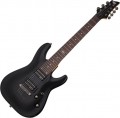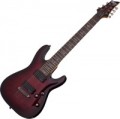Pickups
Type of pickups used in electric guitar.
—
Passive. Passive pickups are called pickups that do not use their own power supply. Such devices produce a weak signal, so guitars with passive pickups require an external preamp. In terms of sound, many musicians consider passive pickups to be more "natural" and dynamic, but this point is largely subjective. The unequivocal advantage of this option is the extensive features for experimenting with the technique of sound extraction. In addition, passive modules are much simpler and cheaper than active modules, and they do not require their own power supplies. On the other hand, these pickups are subject to feedback, which can be problematic in some situations. Yes, and sensitivity to pickups (and, accordingly, the likelihood of interference) they are significantly higher.
—
Active. Pickups supplemented with built-in preamps to increase the level of the signal fed to the output of the instrument. Thanks to the additional amplification, many models have fewer coil turns than passive models, which reduces interference and provides a cleaner and more balanced signal. At the same time, the active module retains the upper frequencies better; this gives the effect of "brightness", "transparency" of the sound. However there is an opinion that this sound turns out to be unnatural, but this moment, again, is largely subjective. But from the unequivocal disad
...vantages of active pickups, one can note the need for their own power source. One of the most popular options for this is a 9V battery, which is installed in a special compartment in the body of the guitar.Type
The type of tone block used in the construction of an electric guitar.
A timbre block is an “intermediary” between a pickup and a guitar output: a set of electronic circuits that provides signal transmission, and often also its processing (volume control, frequency correction, preamplification, etc.). In modern electric guitars, there are such types of tone blocks:
— Passive. Passive are called timbre blocks that do not require additional power sources during operation. Usually, such modules have the simplest design and functionality, adjustments are limited to changing the volume, as well as passively correcting frequencies (by “cutting off” the desired frequencies). At the same time, passive tone blocks are simple, compact, inexpensive and do not depend on batteries; and the necessary adjustments can be made on external equipment (anyway, the electric guitar will need to be connected to it). As a result, most modern instruments are equipped with this particular type of tone blocks.
—
Active. The key difference between a passive tone block is that it needs its own power source to work. Most often, this role is played by a PP3-type battery installed in a special socket in the body of an electric guitar. The need for power is due to the abundance of additional functions: active tone blocks are able to amplify the signal coming from the pickups, suppress interference, and even match the output impedance of the inst
...rument with the input of the amplifier. Yes, and the active method of tone control is more advanced than the passive one, it allows you to more accurately adjust the frequency ratio. On the other hand, active modules are noticeably more expensive, and without a battery, the tone block turns into a set of useless parts. However, such devices consume relatively little energy, and one battery lasts for quite a long time.
— Active/passive. Tone blocks that combine the capabilities of the two options described above. If there is power, such a module operates in active mode, and if there is no power, it turns into passive. Thus, the musician can enjoy all the advantages of the active tone block and at the same time not worry that the instrument will become completely useless due to a dead battery (although, of course, the tone block functionality is not so extensive in the passive mode). At the same time, combined modules are quite complex and expensive, and the real need for such versatility is rare. Therefore, this option has not received much distribution.Mount type
A method of attaching the neck to the body used in an electric guitar.
—
Boltov. The most inexpensive and practical (in terms of production and repair technology) method of attachment: the neck is bolted to the body. Thanks to this, the assembly of the guitar is extremely simple, and the neck can be easily removed from the finished instrument for repair or even replacement with a new one. Note that although the bolt method is considered “low-cost” (and is found mainly in instruments of the corresponding level), it cannot be said that it is definitely worse than other options: guitars of this design have relatively weak sustain, but they give a bright, sharp tone with good attack. They can be used in almost any genre, but they are still considered the most suitable for heavy music.
—
Pasted. A neck mounted in a recess in the body and secured to the recess with epoxy or other adhesive. This design does not allow for such a powerful attack as on bolt necks, but it provides excellent sustain and a pleasant coloration of the sound. And in general, the adhesive connection is considered more advanced, because. better reveals the acoustic properties of wood. On the other hand, such tools are more complicated and more expensive, both in production and in repair, than “bolted” ones.
—
Through. The name of this method is due to the fact that the neck passes
...through the body through and through, to the “lower” (from the side of the bridge) butt. Many instruments of this type, from the back, look as if two additional pieces were attached to the solid piece of wood from which the neck and middle part of the body were carved to give the body the desired shape and width (although the manufacturing technique is, of course, somewhat more complicated). It is believed that the neck-through mount maximizes the capabilities of the wood and allows you to achieve the highest quality sound, with a flat frequency response and excellent sustain. However, such designs are very expensive, and besides, they require extremely careful handling — especially since the repair of a through neck is at best difficult and expensive, and often impossible at all. Note that this option is used mainly in basses, electric guitars with a through mounting method are produced much less frequently.Fretboard radius
The radius of curvature of a fretboard mounted on the fretboard of an electric guitar.
The fingerboard is located directly under the strings, it is to it that the musician presses the strings when playing. If you look at the neck in cross section, its upper part with the overlay will have the shape of an arc; the radius of this arc is implied in this case. The smaller the radius, the more convex this arc will be, and vice versa, a large radius will correspond to an almost flat surface.
In general, it is believed that a smaller fingerboard radius is better for playing chords, and a more even, flat surface makes it easier to play technical passages with an abundance of special techniques such as bands. The average and, one might say, classic diameter value is 12", this is the most popular option among modern electric guitars. The smallest figure is just over 7", it is found in some guitars with Stratocaster bodies (both original Fender instruments and copies ). And the most flat pads have a diameter of 20" or more.
Note that there are often instruments with a variable fretboard radius — smaller at the headstock (where chords are played more often) and larger near the body (where solos are played by notes). In such cases, the radius at the nut is indicated.
Scale
The scale is the distance from the nut to the bridge; in other words, this is the working length of the open (not pressed with a finger) string. The greater this distance, the more tightly the strings must be stretched to achieve the desired pitch and the greater the force required to press them against the fingerboard. However, some guitarists argue that even a small difference in length - less than an inch - already makes a significant difference in the feel when playing.
In addition, this parameter also affects the color of the sound. A longer length allows you to get a brighter, louder and more expressive sound, while a shorter length allows you to get a denser, “warmer” and smoother sound. Thus, all other things being equal, a relatively short scale length is better for playing chords, while a longer instrument may be needed to achieve the desired sound in a solo.
The most popular scale length options in electric guitars (not basses) are
24.75" (Gibson) and
25.5" (Fender). Indicators less than 22" are extremely rare, mainly in instruments with miniature 3/4" bodies (see "Size"), and the maximum value is about 28", longer instruments are practically not produced. But basses have a noticeably longer length ( otherwise the strings for them would have to be made too thick or tensioned too loosely): the shortest models provide a scale length of 30", but the classic value is
34".
Note that the design of the bridge often allows you to change the actual scale length (including for each string separately); This is done to ensure that the instrument plays accurately along the frets. Therefore, in the characteristics it is customary to indicate the default scale length, without additional adjustments.

